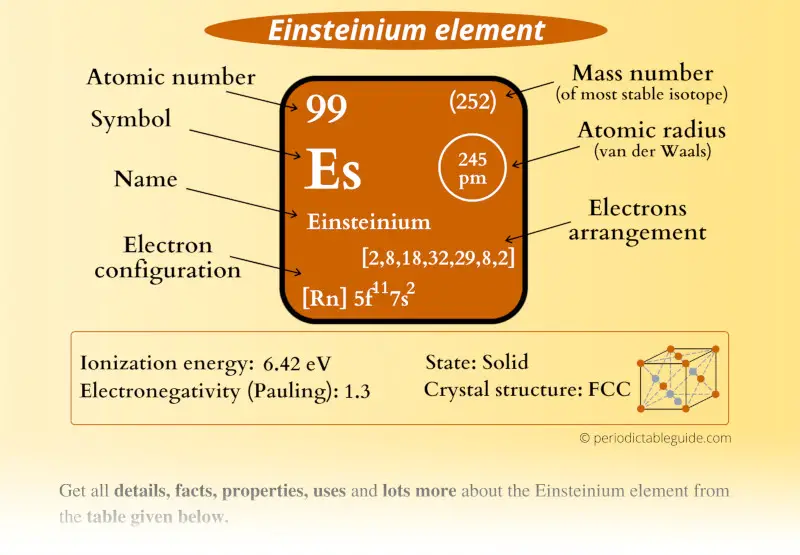
This is a SUPER easy guide on Einsteinium element.
In fact, the table mentioned below is the perfect information box (Which gives you every single detail about the Einsteinium element in Periodic table.)
So if you want to know anything about the Einsteinium element, then this guide is for you.
Let’s dive right into it!
Einsteinium Element (Es) Information
| Appearance | Silvery |
| State (at STP) | Solid |
| Position in Periodic table | 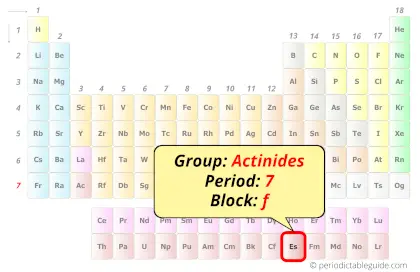 Group: actinides, Period: 7, Block: f |
| Category | 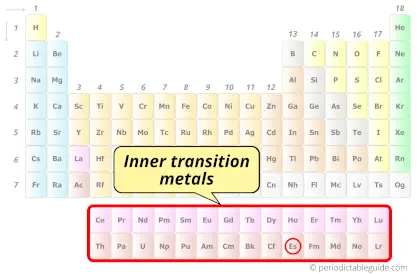 Inner transition metals |
| Atomic number or Protons | 99 |
| Neutrons | 153 |
| Electrons | 99 |
| Symbol | Es |
| Atomic mass of Einsteinium (most stable isotope) | 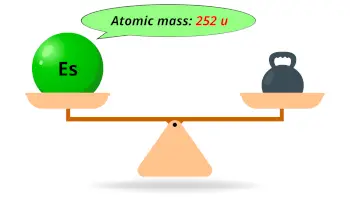 252 u |
| Electrons arrangement or Bohr model | 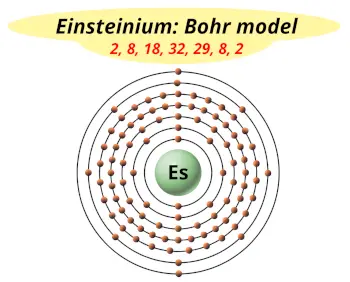 2, 8, 18, 32, 29, 8, 2 |
| Electronic configuration | [Rn] 5f11 7s2 |
| Atomic radius | 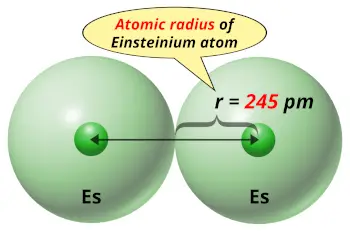 245 picometers (van der Waals radius) |
| 1st Ionization energy | 6.42 eV |
| Electronegativity | 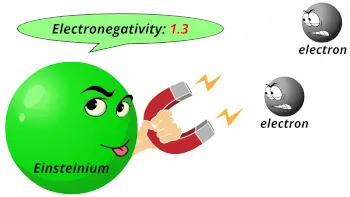 1.3 (Pauling scale) |
| Crystal structure | 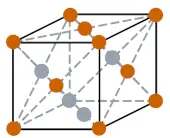 FCC (face centered cubic) |
| Melting point | 1133 K or 860 °C or 1580 °F |
| Density | 8.84 g/cm3 |
| Who discovered Einsteinium and when? | Albert Ghiorso and his team (in 1952) |
| CAS number | 7429-92-7 |
Einsteinium in Periodic table
Einsteinium element is in period 7 and in actinides group of the Periodic table. Einsteinium is the f-block element and it belongs to inner transition metals group.
| H | He | ||||||||||||||||
| Li | Be | B | C | N | O | F | Ne | ||||||||||
| Na | Mg | Al | Si | P | S | Cl | Ar | ||||||||||
| K | Ca | Sc | Ti | V | Cr | Mn | Fe | Co | Ni | Cu | Zn | Ga | Ge | As | Se | Br | Kr |
| Rb | Sr | Y | Zr | Nb | Mo | Tc | Ru | Rh | Pd | Ag | Cd | In | Sn | Sb | Te | I | Xe |
| Cs | Ba | La* | Hf | Ta | W | Re | Os | Ir | Pt | Au | Hg | Tl | Pb | Bi | Po | At | Rn |
| Fr | Ra | Ac** | Rf | Db | Sg | Bh | Hs | Mt | Ds | Rg | Cn | Nh | Fl | Mc | Lv | Ts | Og |
| *Ce | Pr | Nd | Pm | Sm | Eu | Gd | Tb | Dy | Ho | Er | Tm | Yb | Lu | ||||
| **Th | Pa | U | Np | Pu | Am | Cm | Bk | Cf | Es | Fm | Md | No | Lr |
←Move to: Californium (Cf) element – Periodic Table
→Move to: Fermium (Fm) element – Periodic Table
Why is Einsteinium in Period 7?
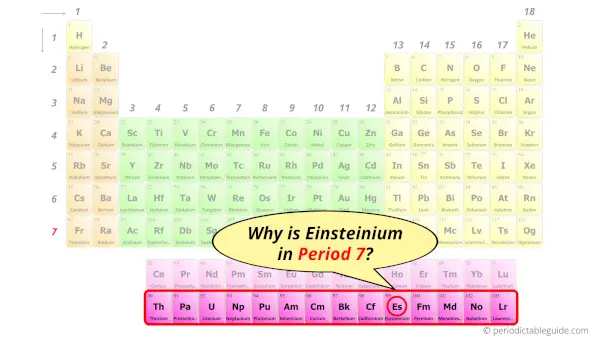
Let me ask you a question.
How many shells does einsteinium have?
It’s 7. Right?
You have already seen the bohr model of einsteinium atom in the above table.
From the Bohr model, it can be found that the number of orbits or shells in einsteinium is 7. Hence, as einsteinium has 7 orbits, it lies in period 7 of the Periodic table.
Why is Einsteinium in f-block?
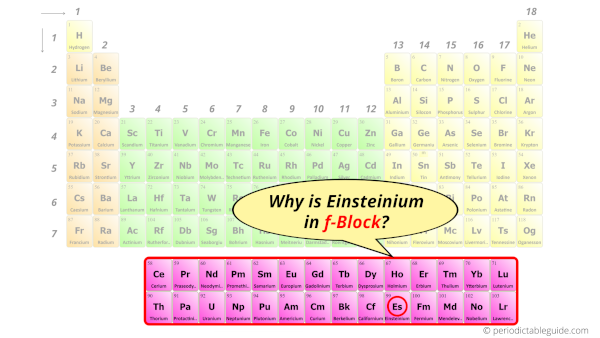
Before knowing this reason, first of all I want to ask you a simple question.
How can you determine the blocks-wise position of elements?
The simple answer: The elements will lie in the s, p, d or f block will completely depend upon the subshell in which the last electron will enter.
For example; the electron configuration of einsteinium is [Rn] 5f11 7s2.
So the last electron of einsteinium enters the f-subshell or f-orbital.
Hence, einsteinium is the f-block element.
5 Interesting facts about Einsteinium
Interesting facts about einsteinium element are mentioned below.
- The element was given the name “Einsteinium” to honor the famous physicist Ablert Einstein.
- Einsteinium was discovered by Albert Ghiorso and his team at Lawrence Berkeley National Laboratory (in 1952).
- Einsteinium is a radioactive element and it is artificially produced in a nuclear reactor.
- Total 19 isotopes of einsteinium are known and all these isotopes are radioactive in nature.
- Out of all the isotopes of einsteinium, the isotope 252Es is the most stable and has a half life of 471 days.
Properties of Einsteinium
The physical and chemical properties of einsteinium element are mentioned below.
Physical properties of Einsteinium
Physical properties of einsteinium are mentioned below.
- Einsteinium is a soft metal having a silvery appearance.
- Einsteinium glows blue in color in the dark, as it releases energy due to radioactive decay.
- The predicted crystal structure of Einsteinium is FCC (face centered cubic).
- The atomic mass of the most stable isotope of einsteinium is 252 u and its density is predicted to be 8.84 g/cm3.
- The calculated melting point of einsteinium is 860 °C.
Chemical properties of Einsteinium
Chemical properties of einsteinium are mentioned below.
- Einsteinium is a radioactive metal and it shows similar chemicals as that of other actinides.
- Einsteinium shows multiple oxidation states, but the most common oxidation state is +3 and +2. It shows +3 oxidation state in aqueous solutions and it shows +2 oxidation state in solid state.
- The calculated first ionization energy of einsteinium is 6.42 eV.
Uses of Einsteinium
Einsteinium is generally used for research work in chemistry. But due to its radioactive nature, it has no commercial uses.
Explore our New Interactive Periodic Table (with Rotating Bohr Models and More)

Details about this Periodic table:
- Access detailed info on all elements: atomic mass, electron configurations, charges, and more.
- View rotating Bohr models for all 118 elements.
- Get a free HD image of the Periodic Table.
Note: For future use, bookmark this Periodic table or visit “PeriodicTableGuide.com”
External resources:
- Einsteinium – Element information, properties and uses | Periodic Table. (n.d.). Einsteinium – Element Information, Properties and Uses | Periodic Table. https://www.rsc.org/periodic-table/element/99/einsteinium
- Einsteinium – Wikipedia. (2007, April 15). Einsteinium – Wikipedia. https://en.wikipedia.org/wiki/Einsteinium
- P. (n.d.). Einsteinium | Es (Element) – PubChem. Einsteinium | Es (Element) – PubChem. https://pubchem.ncbi.nlm.nih.gov/element/Einsteinium
- It’s Elemental – The Element Einsteinium. (n.d.). It’s Elemental – the Element Einsteinium. https://education.jlab.org/itselemental/ele099.html
- Periodic Table of Elements: Los Alamos National Laboratory. (n.d.). Periodic Table of Elements: Los Alamos National Laboratory. https://periodic.lanl.gov/99.shtml
- Redfern, J. (2016, November 22). Einsteinium declassified. Nature Chemistry, 8(12), 1168–1168. https://doi.org/10.1038/nchem.2676
- Discoveries at the Edge of the Periodic Table: First Ever Measurements of Einsteinium. (2021, February 3). Discoveries at the Edge of the Periodic Table: First Ever Measurements of Einsteinium. https://foundry.lbl.gov/2021/02/03/discoveries-at-the-edge-of-the-periodic-table-first-ever-measurements-of-einsteinium/
- Haire, R. G. (n.d.). Einsteinium. The Chemistry of the Actinide and Transactinide Elements, 1577–1620. https://doi.org/10.1007/1-4020-3598-5_12
